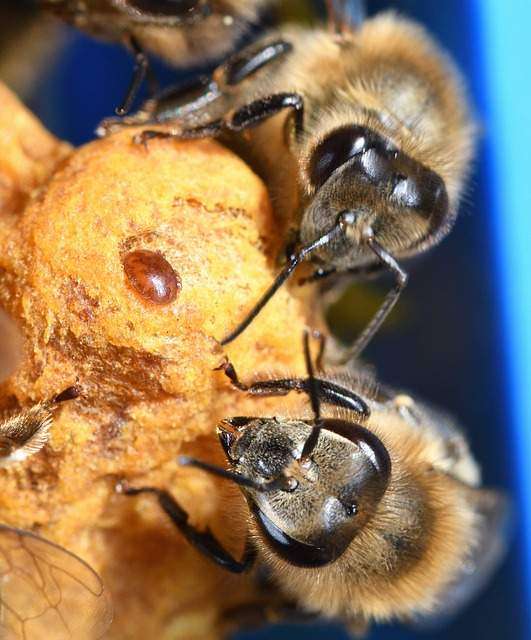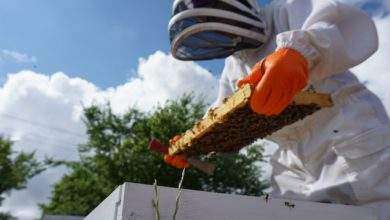Heat Treatment for Varroa Mites

Not much bigger than a pinhead, the biggest danger to honey bees. The varroa mite, a parasite with eight legs and no eyes, can, however, kill enough bees to wipe out an entire colony if left unchecked.
Varroa is a tiny parasite that may be spotted on adult bees with the naked eye. On the bees’ abdomens, they can frequently be seen feeding between segments or fast crawling on other parts of the bees’ bodies.
How did Varroa get here?
Sadly, varroa mites can infect new colonies in a variety of dependable methods. New varroa will enter a hive of bees as soon as you cure it. It is an ongoing struggle.
- Beekeeper Assistance
When beekeepers swap bee or brood frames between hives, or when they split hives, mites are simple to spread across colonies. The transmission of mites may happen more quickly if they keep bees in out yards and move them around.
- Drifting Worker Bees
Not every honey bee returns to the colony where they were born. In a row of hives, it is generally known that the hives at the ends will gradually grow in number while those in the middle will slowly decrease. They are the stray bees, these bees.
In most cases, the new colony will accept these lost bees if they are carrying pollen, nectar, or other essential supplies. But the unseen present might be phoretic mites, which are glad to jump off the bee and settle down, hidden between its segments.
- Wandering Drones
Drones are less picky about where they spend the night than foragers are. Any old colony is highly likely to have a drone drop by, and the foragers normally let them in. Wandering drones are frequently regarded as a significant means of varroa mite transmission.
- Swarming Bees
A swarm will also have mites if a colony does if it does have them. A new mite infection can start with just one of them.
- Absconding Bees
Bees can flee a hive in onesies and twosies rather than usually leaving in huge groups like a swarm.
The bees take out, and some of them may be fortunate enough to find another colony to join, bringing their collection of mites and/or other diseases with them.
- Robbing Bees
A bee colony could be attacked if it starts to show signs of weakness. A sort of kleptoparasitism that is more prevalent in some honey bee races than others, bees from healthy, powerful hives are frequently anxious to empty the pantry of a weaker hive and transport the bounty back home.
The weak hive is frequently infested with varroa mites and may even be on the verge of collapse as a result. The thieving bees wind up with more than they bargained for when they bring home both honey and a vicious infestation of varroa mites. Aha! What do they say about greed?
Treatments for Varroa

In the past, Varroa was managed chemically. In reality, wherever Varroa has been introduced, chemical-based, in-hive treatments have been used as a precaution. In order to combat Varroa, various nations have utilized pyrethroids, organophosphates, essential oils, and organic acids.
It has been shown that Varroa mites can swiftly develop a resistance to chemical treatments.
Chemical Varroa treatments have other negative impacts on honey bees, such as lower queen lifespan, decreased sperm loads in and longevity of drones, brood death, and altered queen laying patterns.
Organic Treatments
Mite infestations can also be managed with the help of naturally occurring substances. There is no proof that these are resistant to mites, but they must still be handled carefully because they can still taint honey.
- Formic acid
The varroa mite is one of only a few pests that can be killed and rendered infertile both on bees and under the brood cap. Simple to use, biodegradable, and leaves no remnant in honey (must harvest two or more weeks after the end of treatment).
- Oxalic acid
It can be vaporized or applied as a powder, it acts when it comes into touch with mites, it is biodegradable, its effectiveness varies, and there is no residue in honey. It is also effective when it comes into contact with mites directly.
The disadvantage is that Oxalic acid is not advised for a colony with honey supers.
- Thymol
Thymol is the most widely used essential oil for preventing varroa mites (from a thyme plant).
Releases vapor into the hive at quantities that kill mites without harming bees, with an efficacy range of 87-97%. This product should not be used when honey supers are present in the hive.
- Powdered Sugar
As a result of the bees’ increased grooming, the mites are forced to release their hold on the honeybees (the sugar is so fine, it interferes with their gripping ability).
Physical Treatments
- Screened Bottom Board
A hive with a ventilated floor needs to be set up for this. Mites that are shed by bees fall through and are unable to re-enter the hive.
Removing solid bottom boards from a bee colony and replacing them with screen mesh can cut down Varroa populations by as much as 14%, while the effectiveness of this method is debatable.
- Brood Control
The varroa’s propensity for drone brood is exploited by a variety of techniques. To eliminate the mites, some beekeepers remove the drone brood frames and freeze them.
Others will remove the drone brood comb when it reaches a specific stage of development. This can be done without harming the colony because hives frequently produce an excess of drone brood.
Hyperthermy or Thermal Treatment
Hyperthermy, also known as thermal treatment, relies on the honeybee’s higher heat tolerance than the varroa mite. The bees will live if heat treatment of 42°C is applied for a few hours, but the varroa mites will perish.
Regardless of the honey harvest or the weather, hyperthermia employs a biological strategy and can be employed throughout the breeding season. Recent methods of conventional heat treatment are quite promising, despite the fact that the initial attempts did not have the desired outcome.
External Heat Treatment
The initial heat treatments heated the entire hive by applying heat from the outside. As a result, the worker bees attempted to cool the brood, which made it challenging to regulate the hive’s temperature and exposed the workers to unneeded stress.
Those methods frequently resulted in bee and queen losses and had only a little impact on the varroa mite. Every brood comb had to be taken out of the colony and heated individually in order to prevent the workers’ cooling behavior.
Unfortunately, the beekeeper would have to spend a lot of time using this strategy, which is why it did not work.
Internal Heat Treatment
Now, new heat treatment procedures have become available, which use a heating system inside the hive to produce heat. In this manner, the Varroa mites are combated in the capped brood, where their infection is most severe. At the same time, the bees are protected from stress and able to maintain the hive’s normal temperature.
The USDA conducted research on this topic back in September 2000, and the findings were somewhat encouraging. Moreover, research has been done in Europe.
For more than 20 years, the Czech Republic, Russia, and Greece have developed and tested thermal treatment devices.
In the last 20 years, technology has advanced significantly.
The efficacy of thermotherapy in controlling Varroa destructor has been demonstrated through experimental research.
Three items that use internal heat therapy for Varroa mites are listed below, all of which are from the US:
Mite Zapper
To kill mites, the “mite zapper” uses a heating element inside the comb in conjunction with mite biology.
Stating that if there is no worker brood in the colony, an estimated mortality rate of over 90% of mites will occur.
Beekeepers merely need to connect two terminals outside a hive to a battery for two to three minutes in order to use this technology, which does not involve opening the hive.
The drone pupae and the mites are both heated and killed by resistant components in the comb. It is feasible to control the temperature so that it just kills mites and spares the drone bees. Beekeepers discard drone bees because they do not contribute much to a typical colony.
The device takes advantage of the biological cycle of the mite’s vulnerable location. As no chemicals are used, honey made in this way is entirely organic.
The benefit of this product is that it is expected to cost less than $10 per unit when it is built and can easily last up to 10 years. The cost would be $1 per colony per year as opposed to $8 per colony each year if chemicals were used.
About this upcoming product, no findings have yet been released.
Mighty Mite
A thermostatically regulated, open-entry unit, the Mighty Mite is introduced from the bottom.
Features include:
- Kills Mites and Hive Beetles
- An industrial grade thermal belt and water proof electronic controller
- The heater belt includes a thermal sensor
- A second sensor is inserted into the center of the hive body
- The controller analyzes the comparative temperature values of both sensors, keeping the temperature at the desired setting
- Product available fitting both 10 or 8 frame hives
As per the directions, you should zap the comb after your colony has reached 70% of its maximum cap size.
According to lab tests, heat stress can cause the failure of a queen and even cause the death of drones at temperatures that are within the mite-kill range.
With this strategy, some beekeepers are concerned that heat stress may have an impact on queen health.
The Victor
This mechanism, which was developed with the cooperation of an electrical engineer who also kept bees, heats the hive from the top, allowing the queen to seek refuge in the cooler area of the colony.
According to Bob Warner, Victor’s creator, this technique’s crucial element is the device’s ability to precisely manage the temperature.
After two treatments of three hours each, The Victor asserts a 95% success rate in eliminating Varroa mites.
Bob describes Victor in this video:
Notably, certain honey bee races can tolerate higher temperatures than others. Carniolans do not tolerate heat as well as Italians, so if you keep them, be mindful of this.
Frequently Asked Questions
- Do all beehives have mites?
These days, varroa mites are so widespread that they are present in almost every hive in the United States.
- How often should you check for mites?
Both Varroa mite and colony populations begin to increase in the spring. Particularly if there is a honey flow, this can be a challenging time to treat. Monthly mite inspections of colonies are recommended.

- Where are the most Varroa usually found?
Due to the fact that a colony’s ability to produce drone broods is typically limited, Varroa is frequently discovered in capped cells that contain worker broods. The capped cell contains the hatching Varroa eggs, and the young mites that emerge from the eggs feed and mate on the honey bee pupa that is growing inside.
- How fast do Varroa mites multiply?
The population of varroa mites doubles every 22 days under the brood cap. Only one female mite is needed for a population to grow from one to fifteen in four months. A western honey bee hive’s mite population can increase by around 12 times in 12 weeks.
- How long does a Varroa mite live?
The sclerites, or hardened plates of the adult honey bees’ exoskeleton, are where adult female Varroa mites can overwinter. These mites typically have a lifespan of two months.
- What temperature kills varroa mites?
The susceptibility to temperature increases in bees and mites varies. Varroa mites cannot survive in environments with temperatures of 104 degrees Fahrenheit or above.
- What is a “Mite Bomb”?
The unexpected invasion of a colony is known as a “mite bomb.” Your healthy hive stealing from an infected colony nearby is frequently the root cause. If a problem is found, act immediately to treat it before the colony suffers.
- How do I protect my bees from varroa mites?
Nowadays, varroa is combated with a variety of pesticides. Three artificial substances—coumaphos, fluvalinate, and amitraz—are placed on plastic strips and hung outside the hive, where bees come into touch with them. Whereas formic acid, oxalic acid, thymol, and beta acids are among the organic remedies available.




